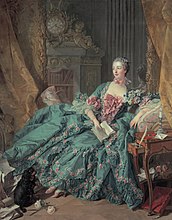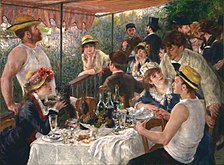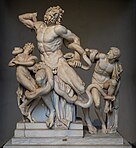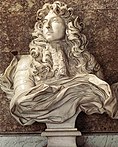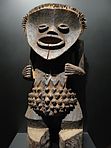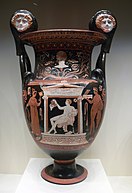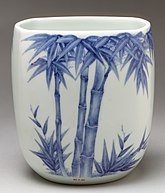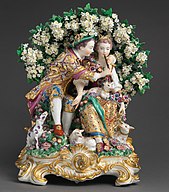Work of art
Awork of art,artwork,[1]art piece,piece of artorart objectis an artistic creation ofaestheticvalue. Except for "work of art", which may be used of any work regarded asartin its widest sense, including works fromliteratureandmusic,these terms apply principally to tangible, physical forms ofvisual art:
- An example offine art,such as apaintingorsculpture.
- Objects in thedecorative artsorapplied artsthat have been designed for aesthetic appeal, as well as any functional purpose, such as a piece ofjewellery,manyceramicsand muchfolk art.
- An object created for principally or entirely functional, religious or other non-aesthetic reasons which has come to be appreciated as art (often later, or byculturaloutsiders).
- A non-ephemeralphotographorfilm.
- A work ofinstallation artorconceptual art.
Used more broadly, the term is less commonly applied to:
- A fine work ofarchitectureorlandscape design
- A production of liveperformance,such astheater,ballet,opera,performance art,musicalconcertand otherperforming arts,and other ephemeral, non-tangible creations.
This article is concerned with the terms and concepts as used in and applied to the visual arts, although other fields such asaural-music and written word-literature have similar issues and philosophies. The termobjet d'artis reserved to describe works of art that are not paintings, prints, drawings or large or medium-sized sculptures, or architecture (e.g. household goods, figurines, etc., some purely aesthetic, some also practical). The termoeuvreis used to describe the complete body of work completed by an artist throughout a career.[2]
Definition
[edit]Awork of artin the visual arts is a physical two- or three- dimensional object that is professionally determined or otherwise considered to fulfill a primarily independentaestheticfunction. A singular art object is often seen in the context of a largerart movementor artisticera,such as: agenre,aestheticconvention,culture,or regional-national distinction.[3]It can also be seen as an item within an artist's "body of work" oroeuvre.The term is commonly used bymuseumandcultural heritagecurators,the interested public, theart patron-privateart collectorcommunity, andart galleries.[4]
Physical objects that document immaterial orconceptual artworks, but do not conform to artistic conventions, can be redefined and reclassified as art objects. SomeDadaandNeo-Dadaconceptual andreadymadeworks have received later inclusion. Also, somearchitectural renderingsandmodelsof unbuilt projects, such as byVitruvius,Leonardo da Vinci,Frank Lloyd Wright,andFrank Gehry,are other examples.
The products ofenvironmental design,depending on intention and execution, can be "works of art" and include:land art,site-specific art,architecture,gardens,landscape architecture,installation art,rock art,andmegalithic monuments.
Legal definitions of "work of art" are used incopyrightlaw;seeVisual arts § United States of America copyright definition of visual art.
History
[edit]This sectionneeds expansion.You can help byadding to it.(April 2024) |
Theories
[edit]Theorists have argued that objects and people do not have a constant meaning, but their meanings are fashioned by humans in the context of their culture, as they have the ability to make things mean or signify something.[5]A prime example of this theory are theReadymades of Marcel Duchamp.Marcel Duchampcriticized the idea that the work of art must be a unique product of an artist's labour or skill through his "readymades": "mass-produced, commercially available, often utilitarian objects" to which he gave titles, designating them as artwork only through these processes of choosing and naming.[6]
ArtistMichael Craig-Martin,creator ofAn Oak Tree,said of his work – "It's not a symbol. I have changed the physical substance of the glass of water into that of an oak tree. I didn't change its appearance. The actualoak treeis physically present, but in the form of a glass of water. "[7]
Distinctions
[edit]Someart theoristsand writers have long made a distinction between thephysical qualities of an art objectand its identity-status as an artwork.[8]For example, a painting byRembrandthas a physical existence as an "oil paintingon canvas "that is separate from its identity as amasterpiece"work of art" or the artist'smagnum opus.[9]Many works of art are initially denied "museum quality" or artistic merit, and later become accepted and valued in museum and private collections. Works by theImpressionistsand non-representationalabstract artistsare examples. Some, such as thereadymades of Marcel Duchampincluding his infamous urinalFountain,are later reproduced as museum quality replicas.
Research suggests that presenting an artwork in a museum context can affect the perception of it.[10]
There is an indefinite distinction, for current or historical aesthetic items: between "fine art"objects made by"artists";andfolk art,craft-work,or "applied art"objects made by" first, second, or third-world "designers,artisansand craftspeople. Contemporary and archeologicalindigenous art,industrial designitems in limited ormass production,and places created byenvironmental designersandcultural landscapes,are some examples. The term has been consistently available for debate, reconsideration, and redefinition.
See also
[edit]- Anti-art
- Artistic media
- Cultural artifact
- Opus number(used in music)
- Outline of aesthetics
- "The Work of Art in the Age of Mechanical Reproduction"
- Western canon
References
[edit]- ^Mostly inAmerican English
- ^OeuvreMerriam Webster Dictionary, Accessed April 2011
- ^Gell, Alfred (1998).Art and agency: an Anthropological Theory.Clarendon Press. p. 7.ISBN0-19-828014-9.Retrieved2011-03-11.
- ^Macdonald, Sharon (2006).A Companion to Museum Studies.Blackwell companions in cultural studies. Wiley-Blackwell. p. 52.ISBN1-4051-0839-8.Retrieved2011-03-11.
- ^Hall, S (ed.) 1997,Cultural Representations and Signifying Practice,Open University Press, London, 1997.
- ^MoMA: The Museum of Modern Art."Marcel Duchamp and the Readymade".MoMA: The Museum of Modern Art.RetrievedFebruary 2,2024.
- ^"There's No Need to be Afraid of the Present",The Independent,25 Jun 2001
- ^"FTC Wins $2.3 Million Judgment Against Gallery Owner In Phony Art Scam"(Press release).Federal Trade Commission.August 11, 1995. Archived fromthe originalon August 4, 2009.RetrievedOctober 29,2008.
- ^"Rembrandt Research Project - Home".rembrandtresearchproject.org.
- ^Susanne Grüner; Eva Specker & Helmut Leder (2019)."Effects of Context and Genuineness in the Experience of Art".Empirical Studies of the Arts.37(2): 138–152.doi:10.1177/0276237418822896.S2CID150115587.
Further reading
[edit]- Wollheim, Richard.Art and Its Objects(2nd ed) 1980. Cambridge University Press.ISBN0-521-29706-0.The classic philosophical enquiry into what a work of art is.
External links
[edit] Media related toArt worksat Wikimedia Commons
Media related toArt worksat Wikimedia Commons


